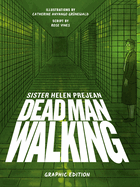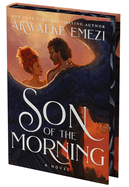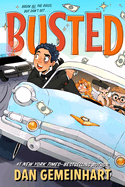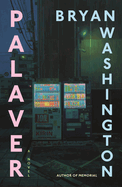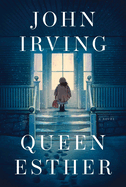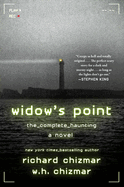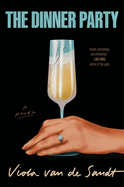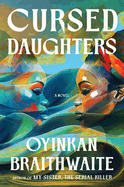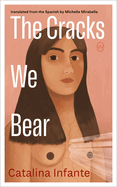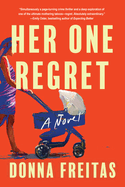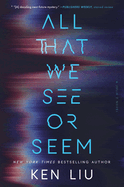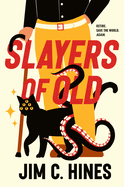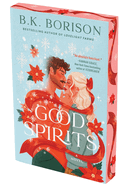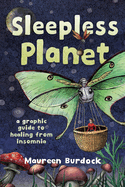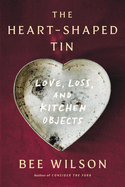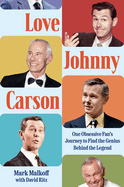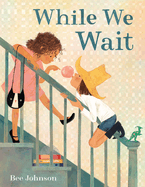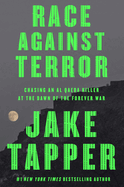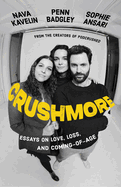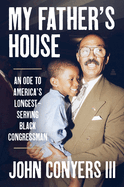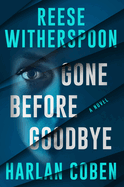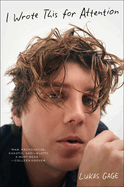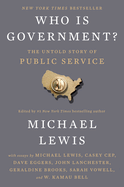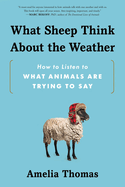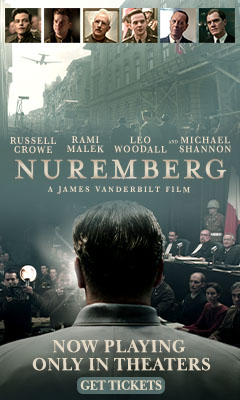Friday, November 7, 2025
I'm nostalgic for muzak, a liminal sound lost since we started carrying handheld entertainment everywhere. I seek it out to soothe my streaming-age decision fatigue. Because silence is harsh and music takes curation, but muzak has an artificial appeal, like the silk flowers in Jory Mickelson's new poem "[Sometimes a hotel room]": "beaded with dew--which is actually glue." The hotel room image then expands into a sky filled with stars before one falls.
Akwaeke Emezi's Son of the Morning orbits Lucifer, the original fallen star, his journey birthing imagination in a place that is neither heaven nor hell. Meanwhile, actor Tim Curry's memoir, Vagabond, sings the very virtues of imaginative wanderers. And Bryan Washington's Palaver roves past and present; through Houston, Jamaica, Japan; traversing a constellation of connections to show how others "help us see ourselves clearer." So, maybe my fondness for muzak is a cousin to that old wisdom about how boredom breeds creativity. Because it's a perfect soundtrack for reading.
Palaver
by Bryan Washington
In Bryan Washington's quietly powerful novel Palaver, a queer Black man who's swapped Houston for Tokyo reconnects with his estranged mother and rebuilds his mental health, thanks to his chosen family.
The central players are only ever "the son" and "the mother." He's found a niche in Japan as a private English tutor and is sleeping with a married man; she came from Jamaica via Canada to raise a family in Texas. They have been out of touch for years when he phones her. Concerned about the son's safety, given his previous suicide attempt, she takes a break from her dental tech job and flies over unannounced. They circle each other uneasily, irritable and quick to take offense. Much remains latent between them, particularly the physical abuse and homophobia that led to their estrangement.
The low-key plot builds through memories and interactions. The close third-person narration expands the view by slipping from present to past and back, drifting to Jamaica and Houston. As in Washington's first novel, Memorial, the characters' cool affect conceals deep emotions. And as in Family Meal, the protagonist gets by with a little help from his diverse friends--here, those who orbit the gay bar Friendly. Trans bartender Alan and the son's kitten, Taro, are additional highlights of the lively secondary cast.
Palaver's broken parent-child bond starts off as defining but melts into part of a whole network of connections. As one character remarks, others "help us see ourselves clearer." Alan adds that simply "showing up" for oneself and others is a vital act of courage. This is Washington's best and most moving work yet. --Rebecca Foster, freelance reviewer, proofreader and blogger at Bookish Beck
Discover: Bryan Washington's emotionally complex third novel explores the strained bond between a mother and her queer son--and their support systems of friends and lovers--when she visits him in Tokyo.
Queen Esther
by John Irving
For anyone who's followed John Irving's nearly six-decades-long literary career, settling into another of his novels feels like stepping into a beloved pair of slippers. But, as he demonstrates in Queen Esther, that sense of homecoming shouldn't distract readers from the insight and empathy that have consistently characterized his work, including this tenderhearted bildungsroman about a writer whose life, not surprisingly, bears some similarity to Irving's own.
Queen Esther tells the story of Jimmy Winslow, whose story is intertwined with that of Esther Nacht, who is Jewish and was born in Vienna in 1905. She emigrates with her parents at age three, and as a teenager, Esther is brought into Jimmy's grandparent's household to serve as an au pair. Irving (Avenue of Mysteries), who has tackled the issue of bigotry against sexual minorities in previous novels, subtly but persistently raises awareness here about the pervasiveness of antisemitism. It manifests in the townspeople's genteel-seeming bigotry, and surfaces in Esther's native Austria, where Jimmy spends his junior year of college, feeling the first stirrings of his dream to become a writer.
With its New England and Vienna settings, presence of a handful of wrestlers, prominent role of an animal, and lots of talk about sexual subjects, many of Irving's familiar tropes are here to delight his longtime readers. At its heart, Queen Esther is a gentle story about identity and family, the one we're born into and the one that, if we're fortunate, grows organically out a lifetime of loving relationships. It clearly reflects John Irving's compassion and generosity of spirit, recognizing our flaws while still focusing on what's best in us. --Harvey Freedenberg, freelance reviewer
Discover: A novel instantly recognizable as the work of John Irving tells an affecting story of a writer's origins and the influence of a strong-minded Jewish immigrant woman on his life.
Bog Queen
by Anna North
Anna North (Outlawed) crafts a narrative of contemporary climate change and ancient druidic history in Bog Queen. This wise and compelling novel grounds the human experience in the long arc of time and poses questions of preservation and legacy through the stories of two women who lived centuries apart and the moss that connects them.
When a woman's body is dug up in a bog in Ludlow, in northwest England, the medical examiner calls on Agnes, a forensic anthropologist. Agnes has "this gift, everyone said it, an instinct for the body and its forms," and her instinct tells her the woman is centuries old, held in the bog "safe under the surface, in [a] bath of earth, for many times her lifespan." As Agnes works to discover who the woman was, she is caught up in conflicting forces surrounding the Ludlow bog: climate activists determined to reflood the bog, companies set on extracting as much peat as possible from it, and developers determined to build new housing atop it.
North moves between Agnes's timeline and the life of the bog queen, a young druid in early Roman Britain. The two women live different lives, in different eras, yet both strive to expand their worlds and move beyond the expectations placed on them by men. Interludes from the bog itself, a living organism and ecosystem, provide the knowledge and perspective of millennia. With layers as dense and interconnected as the bog moss itself, The Bog Queen pays tribute to the persistent forces of nature, the stories humans tell, the stories they live, and the legacies they leave behind. --Kerry McHugh, freelance writer
Discover: A body found in an English bog raises questions of preservation and legacy in this wise and compelling novel of two women who lived centuries apart and the moss that connects them.
Widow's Point: The Complete Haunting
by Richard Chizmar and W.H. Chizmar
An abandoned lighthouse with a gory history attracts a group of ghost hunters in Widow's Point by father-son writing team Richard and W.H. Chizmar. The locals of Harper's Cove, Nova Scotia, consider the Widow's Point lighthouse, built in 1838, to be haunted and cursed. It has been locked up tight since 1988, after decades of bizarre incidents and deaths within and around the premises. But in 2017, author Thomas Livingston gains access for a three-day stay to investigate rumors of its haunting--only to never be seen again, his camera and audio recordings the only chilling remnant of his experience.
In October 2025 a ghost-hunting team arrives to stay for a week within the cold, creaking confines. Joining them is Harper's Cove native and professor Catherine Durand, an author specializing in haunted places, who returns after 33 years to confront the one haunt she has avoided her entire life. The experiment devolves quickly from a spooky lark to a hypnotic descent into horrifying chaos as the lighthouse begins to wake up. The events are revealed through a combination of handheld and stationary camera footage, sound recordings, and Durand's written journal, providing multiple eerie points of view from characters, stairways, and living quarters. These slick narrative devices crank up the freak factor as readers get a 360-degree panorama of nightmarish images. Widow's Point is the ultimate written found footage story that taps into contemporary cinematic and social media trends for peak sinister impact. --Peggy Kurkowski, book reviewer in Denver
Discover: In this sinister found-footage narrative, rumors of hauntings and curses bring a group of ghost hunters to the Widow's Point Lighthouse, and its bloody past comes alive in the present.
Sonora
by Jenni L. Walsh
In her seventh historical novel, Sonora, Jenni L. Walsh arrestingly captures the trials and triumphs of horse diver Sonora Webster. Walsh's first-person narrative traces Sonora's journey from scrappy small-town girl to poised, accomplished performer as she overcomes hardships she never anticipated.
Prodded by her mother to answer a newspaper ad seeking a horse diver, in 1923 Sonora joins Dr. W.F. "Doc" Carver and his traveling act, and she learns to mount a running horse and dive 40 feet into a water tank. While the riding and especially the diving prove a challenge, Sonora must also navigate the tricky dynamics between Doc and his adult children, particularly his son, Al. Sonora quickly falls in love with her new career, even urging her sister, Arnette, to come visit and try horse diving herself. But the road ahead is full of obstacles--including the Great Depression and Doc's declining health.
Walsh expertly conveys Sonora's love for her profession, capturing quiet moments with the horses and the thrill of high diving in a scarlet swimsuit. More subtly, she shows Sonora's growing confidence and the ways a performing career offered power and agency to women at a time when they had only recently gained the right to vote. When an accident threatens Sonora's beloved career, she must dig deep to find the courage to dive again--not only from the tower but also into a whole new life.
With pulse-pounding drama, dry humor, and lots of heart, Sonora is a fitting tribute to a woman who captured audiences with her glamour, guts, and courage. --Katie Noah Gibson, blogger at Cakes, Tea and Dreams
Discover: Jenni L. Walsh's thrilling seventh historical novel traces the challenges, triumphs, and heart-pounding adventures of horse diver Sonora Webster.
The Dinner Party
by Viola van de Sandt
The Dinner Party, Viola van de Sandt's propulsive debut, is structured around one fraught dinner party and the far-reaching ramifications it has on Franca's life after a somewhat unwilling stint as its hostess. Franca's account of the doomed evening begins as a collection of facts in an unsent letter she is writing at the behest of her therapist. Her report of the meal is carefully organized, starting with prep and mise en place and continuing right up to the sickly sweet spill of chocolate frosting at dessert. But amid that careful organization is lurking "that business with the knife," the alluded-to denouement of the evening that launches Franca out of her constructed life and into something for which she has no menu, no plan, no recipe--something that, if she can only get there, might feel begin to feel like freedom.
Van de Sandt moves expertly through time in The Dinner Party, weaving together past and present to great effect. The intimate dinner party, thrown at the insistence of Franca's partner, is meant to celebrate a successful investment in his portfolio--and represent the role Franca plays as a dutiful housewife-to-be. With her therapist's support, Franca fills in some of the blanks of her memory around the event and the ways those lost memories and forgotten traumas hide within a person: her father's early death and her mother's year-long silence afterward.
With sharp prose and emotional clarity, The Dinner Party is the tale of one woman coming to know about herself and about life, a breathtaking, fast-paced tale of a woman's hurt and rage and anger and despair and becoming. --Kerry McHugh, freelance writer
Discover: This debut novel spans the length of one doomed dinner party and the far-reaching implications it has on its unwilling hostess, in a propulsive tale of female rage and becoming.
Cursed Daughters
by Oyinkan Braithwaite
A young woman's escape from a troubling family legacy hangs in the balance in Cursed Daughters by Nigerian British writer Oyinkan Braithwaite. With scenes set in the present and forays into the past capturing the generational scope of her story, Braithwaite (My Sister, the Serial Killer) blends satire and high drama to deliver a spectacular saga glowing with romance and otherworldly intrigue.
The women of the Falodun family of Lagos, Nigeria, have struggled under a curse for five generations. The malediction was originally placed on their beguiling ancestress Feranmi by her husband's scorned first wife, who warned that Feranmi's female descendants would never find lasting love. The curse seems to be working. The Falodun ancestral home is a refuge for those heartbroken by absconding husbands and weak-willed lovers.
Braithwaite's stellar storytelling is boosted by her skillfully crafted characters. For charismatic Monife, the pivotal center of Cursed Daughters, her failed relationship with Kalu has as much to do with the curse as her fear of it. Heartbroken over Kalu's betrayal, Monife drowns and then is buried on the very day her cousin gives birth to Eniiyi. Eniiyi's startling resemblance to Monife leads to superstitious chatter about reincarnation, and her childhood is weighed down by the haunting shadow of her dead aunty. As a college graduate, Eniiyi pursues a career as a genetic counselor.
Curse or not, when love comes for Eniiyi, it does so with a force that leaves her smitten and leads to a long overdue collision course with mysteries from Monife's past. The fallout is devastating yet Braithwaite's masterful conclusion finds hope in the enduring power of love. --Shahina Piyarali
Discover: A young woman's escape from a troubling family legacy hangs in the balance in this satirical drama fueled by romance and otherworldly intrigue that's set in Lagos, Nigeria.
The Cracks We Bear
by Catalina Infante Beovic, transl. by Michelle Mirabella
The Cracks We Bear, a raw, spare novel sparked by new motherhood, marks a joint English-language debut for Chilean author/publisher Catalina Infante Beovic and translator Michelle Mirabella, who previously translated Infante Beovic's short stories.
Laura birthed Antonia with "animalistic screams." What Laura wanted most to have during the delivery was her mother Esther's Santa Teresa medal, which Esther would "always put on when she was afraid to face things." But the medal is lost, and Esther long dead. "You don't just miss a mother who dies; it's another emotion, difficult to name," Laura muses. Without her own mother, Laura's journey into parenthood feels like a dark enigma. Antonia overwhelms Laura: "I can't do this... I don't want to be a mom." Laura was just 18 when Esther died, their relationship complicated and painful in life.
As Laura embraces Antonia, she realizes, about Esther, that "trying to understand who you were, what we were" will always be intertwined with her own experience of motherhood. Laura's "therapist says relationships are full of cracks, that they're... these ordinary earthen jugs that have been pieced back together over and over again." Infante Beovic illuminates these cracks with longing and loneliness, exhaustion and first smiles. Her sharp insights are revelatory, reframing an "irrefutable," joyful photograph as evidence that mother and daughter face a coming rift.
Mirabella's translator's note adds her own transformative experience with The Cracks We Bear, which she first read in 2022 "as a daughter" and finished translating as a mother, having since had her own daughter. With empathic perception, author and translator present a nuanced, haunting journey of new (and old) motherhood. --Terry Hong
Discover: Chilean author Carlina Infante Beovic's penetrating English-language debut sharply examines the overwhelming challenges of new motherhood haunted by the complications of painful daughterhood.
Minor Black Figures
by Brandon Taylor
The question of whether an artist should tell another person's story animates Minor Black Figures by Brandon Taylor (Real Life), a literary provocation that probes notions of grace, morality, free will, and the role of artists in the debate over society's most pressing issues. Wyeth is a gay, Black artist who shares a Manhattan studio with several other creatives. He has made a series of paintings inspired by films from European cinema, most notably Ingmar Bergman's Winter Light and the works of French New Wave director Éric Rohmer. Wyeth replicated stills from Rohmer's work, but with Black people instead of white characters. When he sold one such painting, "people thought [he] was talking about Floyd and Kaepernick," a misunderstanding that led to disappointment in his future work.
Anyone who makes art will feel the tug of Wyeth's dilemma, rendered in heartfelt scenes infused with philosophical brooding, as he searches for a new subject. He's soldiering through a job at a gallery and another one with an Upper West Side restorer, and he seethes over a collective called MangoWave, artists who "were geniuses at turning the game of social capital into paintings. They were simply doing it with brown people and calling it radical." When Wyeth begins a relationship with Keating, a white man "on a break" from his time as a Jesuit priest, Wyeth thinks he may have found that elusive theme. Nothing is that simple, however, as readers discover in this fine novel, a complex work unafraid to raise profound moral questions. --Michael Magras, freelance book reviewer
Discover: Minor Black Figures by Brandon Taylor examines the question of whether artists should co-opt others' identities in this story of a gay, Black artist in New York struggling to find his next subject.
Mystery & Thriller
Her One Regret
by Donna Freitas
Donna Freitas's Her One Regret explores what one of her characters calls "the last taboo of motherhood." At once a rocket-paced crime tale of suspense and a thoughtful examination of cultural dictates about motherhood, this novel of women's lives and relationships excels as both entertainment and a call to difficult but necessary conversations.
On a gorgeous, early fall afternoon, Lucy loads groceries alongside her nine-month-old daughter, Emma. Then begins Part I: Lucy has vanished; Emma is found, alone, crying, but perfectly fine, in the parking lot. The small Rhode Island community is horrified, united in a search for the missing mother. But then it is revealed that Lucy had recently confided in her best friend, Michelle, that she regretted having Emma. She had fantasized about staging her own disappearance. The community and the nation erupt in harsh judgment.
The rest of Freitas's narrative jumps between the lives of four local women. Michelle is devastated by her best friend's disappearance, in love with her own role as mother, but galvanized to defend her friend. Diana, a retired detective, is drawn to Lucy's case and its similarities to other vanished women. And then there is Julia, whose baby is the same age as Emma. Julia sees herself in Lucy, shares the fantasy of escape, and now watches as the world condemns her parallel self. Her desperation feels like an emergency no one around her will acknowledge.
Freitas (Consent) relates these lives, and quiet--or in Lucy's case, suddenly very public--struggles with nuance and compassion. Her One Regret is purposefully thought-provoking and a riveting mystery--a masterpiece of duality, not soon forgotten. --Julia Kastner, blogger at pagesofjulia
Discover: A young mother confesses regret in this satisfying, dynamic mystery that is also a rousing conversation starter about an experience of motherhood still treated as taboo.
Science Fiction & Fantasy
All That We See or Seem
by Ken Liu
A young hacker is pulled from the quiet life she has built for herself to solve the mystery of a missing dream artist in All That We See or Seem, the first in a gripping science-fiction thriller series from Ken Liu (The Hidden Girl; The Paper Menagerie and Other Stories).
Julia Z gained notoriety in her past as the "orphan hacker." Now, she maintains a minimal digital footprint and struggles to pay the bills. But when lawyer Piers Neri comes to her for help to determine whether a ransom video for his missing wife is legitimate and, if so, where she might be, Julia winds up in the alleged kidnapper's crosshairs.
Piers's wife, Elli Krantz, is an oneirofex, an artist who weaves together the dreams of an audience for a "vivid dreaming" experience. The video came from someone she had been dreaming with one-on-one, and to free her, he demands that Piers send him something he claims Elli took.
Liu has created an inventive vision of an AI future, full of thrilling near escapes by engaging and clever characters. Julia's inclination toward anonymity means she has never participated in vivid dreaming; discovering what the ransomer wants will require her to find new ways to use her hacking skills, manipulating the remnants of files from vivid dreams that were never intended to be recoverable. All That We See or Seem does not contain much moral ambiguity, but Liu's thoroughly despicable villains here are nonetheless fun foils for Julia's heroism. Readers will be eager for the next installment of Julia's adventures. --Kristen Allen-Vogel, information services librarian at Dayton Metro Library
Discover: A hacker searches for clues to a real disappearance in virtual dreams in this gripping science-fiction thriller.
Slayers of Old
by Jim C. Hines
In Jim C. Hines's sassy and adventurous contemporary paranormal fantasy Slayers of Old, a middle-aged slayer, a demon working at becoming a more involved grandmother, and an elderly wizard who share a magical house-cum-bookstore must team up against the arcane, the evil, and the dangers of overindulging in dairy.
Jenny was fated to life as a monster-slaying Hunter of Artemis by a millennia-old council of elders who "bound young girls to a life of power and violence, never realizing just how creepy and messed-up that was." Now 56 years old and estranged from the council and her goddess, she heals the less-harmful creatures she once hunted and runs a bookstore with her housemates Annette, a retired half-human, half-succubus private eye whose career left her with strained family ties, and Temple, a once-mighty wizard who at 99 is showing signs of flagging strength. Their fragile peace shatters when a shadowy figure tries to raise an ancient, malevolent force. They must band together to save their town and the world, and maybe, finally, defeat their personal demons.
Hines (the Magic Ex Libris series) riffs on tropes and characters from the paranormal urban fantasy trends of the 1990s and early 2000s in this wisecracking, endearing speculation on how versions of a few favorite characters might have approached navigating their later years. The butt-kicking action scenes, dark atmosphere, and world-building and lore that made the subgenre a hit are very much in evidence in this story of found family and fighting for what matters. --Jaclyn Fulwood, blogger at Infinite Reads
Discover: A middle-aged monster slayer, a half-succubus PI-turned-grandmother, and an aging wizard must prove they can still save the world in this funny, action-packed riff on vintage paranormal fantasy.
Romance
Son of the Morning
by Akwaeke Emezi
Akwaeke Emezi (Freshwater; The Death of Vivek Oji) builds twists and turns into the plot of Son of the Morning, a propulsive story that brims with sexy scenes and sensual details as it literally straddles Heaven and Hell--and the mortal Earth between them.
Galilee knows she is not like her "sisters." She feels loved in her all-woman community, but she senses unease from some of the others. Bees swarm around her protectively, and she has a gift for healing. Once she turns 25, Galilee sets out for the nearby U.S. city of Salvation to live on her own.
She meets wealthy Oriakụ and horror writer Bonbon. Oriakụ invites the two to her father's palatial house to view an ancient artifact, but the guards that protect it bar their entry and call in their boss, Helel. Galilee sees him, and the effect is instant and electric. What follows is some of the hottest sex put to page, and their union leads to the collision of Heaven and Hell. The artifact serves as a gate holding back the demons of Hell, and those demons' escape could mean "holy obliteration" for Lucifer (Helel's true identity) and his princes.
Emezi, with whiffs of William Blake, brilliantly reframes questions around Lucifer's fall and its role in the birth of imagination. This breathtaking novel will have readers questioning the definitions of angel and devil, good and evil, right alongside Galilee. The angels and devils make their cases to win her; her choice could save the world--or destroy it. Only Galilee can free herself and, in so doing, experience her own limitless powers to heal. --Jennifer M. Brown
Discover: Akwaeke Emezi's breathtaking novel of finding one's identity materializes on an epic scale, as Galilee Kincaid straddles Heaven and Hell to take her rightful place.
Good Spirits
by B.K. Borison
A people pleaser falls for the Christmas ghost assigned to haunt her in Good Spirits, an incandescent holiday romance by B.K. Borison (First-Time Caller; Business Casual). Irish fisherman Nolan Callahan has spent the last century as a Ghost of Christmas Past, helping people change their ways before it's too late. When he appears before Harriet York, however, what should be a simple task--revisiting some of Harriet's memories and forcing her to reckon with her bad behavior--proves difficult. Reindeer-pajama-wearing Harriet has no idea what she's done; she's not only full of Christmas spirit but she's also a good person who does her best to make others happy.
As they spend time in Harriet's memories and grow closer, Nolan's magic starts behaving in unusual ways. He wonders whether he'll be able to complete his assignment by Christmas Eve and what will happen to his and Harriet's deepening relationship when he must leave.
Borison balances Nolan's vocational and existential woes with a full narrative arc for Harriet. Ever since she quit her legal career and took over her aunt's antiques shop, Harriet has worked to brighten the days of everyone around her, including her status-obsessed parents. Processing her past with a sexy ghost may be just the boost she needs to finally prioritize the things and people that make her happy in the present.
Good Spirits is everything reader could want from a holiday romance: plenty of cozy and toe-curling scenes, Christmas magic, and two good people falling in love. Fans of Christina Lauren's In a Holidaze and the Hallmark movie The Spirit of Christmas should put this on their wishlist. --Suzanne Krohn, librarian
Discover: A Ghost of Christmas Past falls for his Christmas-loving assignment in this sparkling holiday romance from Lovelight Farms author B.K. Borison.
Graphic Books
Dead Man Walking: Graphic Edition
by Helen Prejean and Rose Vines, illus. by Catherine Anyango Grünewald
Sister Helen Prejean's bestselling memoir, Dead Man Walking, becomes a graphic masterpiece with a script by Rose Vines, who's worked closely with Prejean since 2002, and superb illustrations by award-winning Swedish Kenyan artist Catherine Anyango Grünewald. In the appended timeline that highlights relevant events since the memoir's 1993 publication, the penultimate entry marks Donald Trump's November 2024 promise of "dramatically expanding the use of the death penalty." That threat underscores the gravity of introducing Prejean's classic to new generations.
As a member of the Sisters of St. Joseph of New Orleans, Prejean initially reluctantly "assented" to the 1980s "reform movement sweeping the Catholic Church that harnessed religious faith to social justice." When asked, she agreed to write to a death-row inmate as part of her newfound commitment to act against systemic injustice. The resulting transformative relationship with convicted rapist/murderer Elmo Patrick Sonnier ignited her lifelong activism against the death penalty. Without ever minimizing heinous crimes, Prejean recognizes and respects individual humanity, exposing the inhumanity of legalized execution.
Grünewald's remarkable visual adaptation incorporates complicated layers of morality, race, socioeconomics, and legal failures faced by prisoners, staff, victims' survivors, supporters, detractors. She brilliantly captures Prejean's complex internal struggles. Grünewald line draws in grayscale, with colorful splashes and shading for highlights and emphasis; rare but glorious are the full-color panels and pages. A dual chorus comprised of a challenging ant ("Is this an evisceration of the Eighth Amendment?") and knowing owl ("So it would seem") adds pithy commentary. In its artfully potent incarnation, this profound accomplishment deserves significant readership. --Terry Hong
Discover: The graphic adaptation of Sister Prejean's classic memoir, Dead Man Walking, delivers a timely, visually resplendent experience.
Sleepless Planet: A Graphic Guide to Healing from Insomnia
by Maureen Burdock
Sleepless Planet, Maureen Burdock's second graphic narrative (after Queen of Snails), combines memoir, cultural critique, and medical research in a lively and enlightening exploration of insomnia as a global problem and a symptom of societal and ecological imbalance.
Having struggled with insomnia for most of her life, Burdock embarked upon a journey to root out the causes and get some sleep. She details that journey in four parts, corresponding to the elements: "Air," "Fire," "Earth," and "Water." In "Air," Burdock looks at methods of alleviating sleep apnea, more common now due to soft-food diets, and learns to play the didgeridoo. In "Fire," she examines the effects of menopause and stress on sleep and discusses how overmedication with hormones and statins increases metabolic issues. "Earth" considers circadian rhythms and how exposure to screens disrupts sleep, and "Water" appraises meditation as a helpful tool with which to fight insomnia. Burdock shares well-documented research dispelling myths about nutrition and the dangers of mass-produced seed oils and ultraprocessed foods, and offers some useful cognitive behavioral therapy exercises to break the insomnia cycle.
Through her intricate and often whimsical illustrations, Burdock uses humor to great effect, complementing her discerning analysis. A helpful koala named Kiki backs up Burdock's narrative with relevant facts, for example, and drawings of beds transformed into monsters with teeth perfectly convey the anxiety of sleeplessness. Although insomniacs may not have access to all the resources Burdock employs in her ultimately successful quest for sleep, every reader will find useful information in this intelligent, heartfelt, and beautifully illustrated work. --Debra Ginsberg, author and freelance editor
Discover: This exploration of insomnia blends memoir, medical research, and cultural critique in an informative and beautifully illustrated graphic narrative.
Food & Wine
The Heart-Shaped Tin: Love, Loss, and Kitchen Objects
by Bee Wilson
British food journalist Bee Wilson turns her keen eye on kitchenware--and the deep emotions it engenders--in her engaging, insightful ninth book, The Heart-Shaped Tin. Wilson (First Bite) delves into the varied roles of cherished kitchen objects. She draws together meticulous research; interviews with chefs, immigrants, and others who hold dear their often-used kitchenware; and her own experience with her kitchen paraphernalia as she navigated her divorce, her mother's dementia and death, and her two older children leaving home.
Wilson recounts the incident that sparked the book: the titular heart-shaped tin, an enduring symbol of her marriage, fell out of its cupboard just months after her husband left her. Wilson kept the tin, but knew she wasn't yet ready to use it for any new, post-divorce occasions. Instead, she began searching for other people who harbored "intense and even magical feelings" about their kitchen items.
As she describes the objects and examines the meaning they hold for their owners, Wilson broadens her exploration to well-known cooking artifacts, such as the "poetry jars" made by enslaved American potter David Drake in the mid-19th century. She muses on cultural associations with cooking and serving food, but also with owning prestige objects, like her mother's cream-colored Aga stove.
Wilson's heart-shaped tin gets its redemptive turn when Wilson bakes her milestone birthday cake in it. She shares the cake with her children, and honors her mother by pulling out her mother's cherished set of platters.
Poignant, thought-provoking, and lavishly detailed, The Heart-Shaped Tin is a moving tribute to the objects that shape our lives in (and out of) the kitchen. --Katie Noah Gibson, blogger at Cakes, Tea and Dreams
Discover: Bee Wilson's poignant, insightful ninth book examines the complicated layers of meaning imbued in kitchen objects by their owners.
Biography & Memoir
Vagabond: A Memoir
by Tim Curry
Most people's first glimpse of Tim Curry was probably as Dr. Frank-N-Furter, the "sweet transvestite from Transylvania," in the 1975 film The Rocky Horror Picture Show. But as Curry's delightful memoir, Vagabond, shows, the British actor's prolific career began with his 1968 debut in the London stage production of Hair.
With a strong, affable voice, Curry warns readers not to expect a gossipy tell-all, an assertion he sticks with as he frankly recounts his life but never gives hints about his loves. Actors, he notes, were "considered rogues and vagabonds" during William Shakespeare's time. That could easily describe Curry's childhood and profession, careening from project to project. He was born in Cheshire in 1946, and his family's frequent moves due to his father's work as a Royal Navy chaplain taught him "the scope and powers of my own imagination." His father died from pneumonia following a stroke at age 45, when Curry was 11. His often-distant mother didn't allow him or his 15-year-old sister, Judy, to attend the funeral. He later discovered theater at boarding school.
Curry enthusiastically reminisces about his stage, screen, and voice acting career (13 pages of credits shows just how active), offering insight on iconic roles (Dr. Frank-N-Furter, Pennywise, Wolfgang Amadeus Mozart) without preciousness, and approaching the smallest or most villainous roles with equal aplomb. He also discusses bouts with alcohol and drugs, as well as the 2012 stroke that caused him to use a wheelchair. When he does mention other figures in show business, it is with respect and gratitude, a recurring theme of this highly entertaining memoir. --Oline H. Cogdill, freelance reviewer
Discover: The prolific actor Tim Curry offers a delightful look at his life and career in this highly entertaining memoir.
History
The Great Contradiction: The Tragic Side of the American Founding
by Joseph J. Ellis
Historian Joseph J. Ellis (Founding Brothers; The Cause) takes on the creation of the United States and the Constitutional Convention in The Great Contradiction: The Tragic Side of the American Founding. He discusses the contemporary tendency to place Washington, Jefferson, and other founders on pedestals and focuses on their two enormous failures: the violent displacement of Native Americans and the continued brutal enslavement of hundreds of thousands of Africans.
Ellis argues that a significant reason why the founders avoided the questions of slavery and land seizures is that "moral blindness made eminent economic sense." Thus from the beginning, the U.S. ignored the advice of Benjamin Franklin to put slavery on the national agenda, resulting in the Civil War and centuries of racism and injustice. Similarly, for the Native American populations of the new United States, victory in the American Revolution "proved an unmitigated calamity," setting the republic on a path that ultimately culminated in the Indian Removal Act of 1830.
Leaning on new research about the Atlantic Slave Trade and primary documentation from the previous books he has written, Ellis covers these contested historical origin stories in fresh and intriguing ways. The Great Contradiction pulls no punches about the flaws of the founding fathers: "Next to the failure to end slavery, or at least put it on the road to extinction, the inability to reach a just accommodation with the Native Americans was the greatest failure of the revolutionary generation. And they knew it." Fans of U.S. history--or those who recognize "the presumption of white supremacy that had its origins and first chapter in the American founding"--are sure to appreciate The Great Contradiction. --Jessica Howard, former bookseller, freelance book reviewer
Discover: In this sweeping work, historian Joseph J. Ellis discusses the two primary failures of the U.S. founding fathers: slavery and Native American land rights.
Performing Arts
Love Johnny Carson: One Obsessive Fan's Journey to Find the Genius Behind the Legend
by Mark Malkoff
Johnny Carson (1925-2005) hosted The Tonight Show for 30 years, racking up 23,000 guests. Not quite as impressive but an accomplishment just the same: comedian Mark Malkoff hosted The Carson Podcast for eight years, notching 400 guests. Many of them--largely Tonight Show couch sitters and insiders--shared invaluable and record-correcting insights that Malkoff includes in his beguiling valentine, Love Johnny Carson: One Obsessive Fan's Journey to Find the Genius Behind the Legend.
The book probably contains just enough of Carson's backstory to meet the legal definition of a biography. While Malkoff touches on his subject's middle-class Midwestern upbringing, his focus is the show that Carson began hosting in 1962, when he took over for Jack Paar. Malkoff submits that Carson's Tonight Show worked because of his "cordiality, calmness, cool, warmth, wit, and love"--qualities that the book demonstrates coexisted with some offscreen character flaws (philandering, emotionally distant parenting). The careers of Carson's guests had a way of exploding following their Tonight Show appearances (see Jay Leno and Joan Rivers). Meanwhile, Carson had a retaliative streak that was out in full force when a guest crossed him (see Jay Leno and Joan Rivers).
Love Johnny Carson can read like an oral history as Malkoff's podcast interviewees assess Carson's talents and dissect his monologues and skits to determine how the comedy sausage was made. Like a golden-age talk show, Malkoff's book is a breezy entertainment with an easygoing style that conceals all the grueling work that surely went into making it. --Nell Beram, author and freelance writer
Discover: In this beguiling valentine, comedian Mark Malkoff, who hosted The Carson Podcast for eight years, toasts Johnny Carson and his 30-year Tonight Show run.
Children's & Young Adult
Busted
by Dan Gemeinhart
In the hilarious, outrageous, and heartwarming novel Busted by Dan Gemeinhart, a 12-year-old rule follower unwillingly teams up with an ex-mobster and a snarky girl to get cash for his grandfather's skyrocketing rent.
Oscar Aberdeen has lived his entire life with his grandfather, Pops, at the Sunny Days Retirement Community, and it shows. His language ("humdinger," "malarkey," "hogwash") and cultural references (Frank Sinatra, PBS NewsHour) skew 80-something. His strict sense of responsibility, which at Sunny Days includes planning anniversary parties, playing bridge, and giving eulogies, makes him an honorary grandson for most of the residents. Life is "a-okay," until the rent is raised impossibly high and Oscar and Pops face eviction. So, when new resident Jimmy "I wasn't no mobster" Deluca approaches Oscar with a "business proposition," Oscar is intrigued despite his tummy telling him no.
What follows is madcap entertainment on a cinematic scale. Oscar (who becomes "Kid Ravioli"), Jimmy ("the Wrench"), Jimmy's hairless cat, Mr. Buttercup, and 12-year-old tagalong Natasha ("No Nuts") embark on an over-the-top adventure that includes hot-wiring and stealing a car, visiting a prisoner ("Thumbs") in the state penitentiary, and joining a decades-old "illegal secret poker game." Jimmy is comically stereotypical as a mafia "fixer," and the dynamic among caustic Jimmy, uptight Oscar, and smart-aleck Natasha provides a droll tension throughout, especially since all three have (sometimes) hidden hearts of gold. In Busted, storyteller extraordinaire Gemeinhart (The Remarkable Journey of Coyote Sunrise; Some Kind of Courage) gives readers another thoroughly absorbing novel with nonstop action and lovable characters. --Emilie Coulter, freelance writer and editor
Discover: In Dan Gemeinhart's extravagantly entertaining and affecting novel, a self-contained, self-controlled 12-year-old embarks on a spree of madcap capers, finding unexpected joy in the tumult.
Heartsick
by Kristina Forest
Author Kristina Forest is known for writing warm, resonant romance for teens and adults. In Heartsick, a rapidly paced, YA romantic mystery, Black teens Margot and Isaac discover a pharmaceutical company is lying about the dangerous side effects of their extremely popular drug.
Senior Margot Whitman's college plans don't align with those of her controlling parents: Margot is serious about being a journalist, but her parents believe "jobs in print media aren't reliable anymore." They insist she intern at Healing Hearts Inc., the pharmaceutical company "responsible for the ingestible pill that can cure a person's heartbreak." Margot has even considered taking the $500 pill herself after her recent breakup with artistic Isaac Fisher. Nonetheless, she is shocked when Isaac shows up at Healing Hearts. Isaac, whose focus has been failing after the breakup, immediately regrets his decision when he sees Margot. He bolts, and Margot retreats to a back room where she overhears a one-sided conversation in which the COO mentions "patient complaints," "migraines," hospitalization for vomiting, and assures someone that these individuals "won't talk anymore." When Margot is discovered eavesdropping, Isaac helps her escape the center, but the teens are now on the run from a powerful corporation. Isaac, Margot, and all their complicated feelings must team up to tell people the truth about Healthy Hearts.
Forest (Zyla and Kai) provides a rapidly moving chase and sentimental love story with both mystery and thriller elements. Through the protagonists' first-person points of view, readers are invited to consider the morality and ethics around the idea of erasing heartbreak. Heartsick is a heart-healthy read for fans of Nicola Yoon and Jenny Han. --Natasha Harris, freelance writer
Discover: A sweet, fast-moving, near-future romance about two teens working together to expose a corrupt pharmaceutical company.
While We Wait
by Bee Johnson, illus. by Bee Johnson
Author/artist Bee Johnson's second picture book, While We Wait, following 2024's What Can a Mess Make?, combines jaunty verse with inviting full-color spreads that capture a spirited day of errands for a parent and two young children. The handwritten "to do" list on the refrigerator, appended with a "BE BACK SOON"-Post-it from Dad, provides a clever preview of what's ahead even before the title page.
Leaving home is rather chaotic: an unfinished cereal bowl on the table, a frantic search for "phone and wallet./ Missing bag." The waiting siblings energetically pass the time with "chase and tag" before the trio finally heads out the door. While the parent shops at the summer market, a drummer and playful dog provide welcome distractions. As adults chat outside the vintage shop, a friendly Dalmatian invites attention; inside, the hats, glasses, and fancy dress prove too irresistible to not "make a mess." Hunger, alas, causes the kids to "fall apart," but an after-lunch rainstorm provides an opportunity for a joyful "stomp and splash" to end a day of "miles walked and/ errands run." After "soup for supper./ Bellies fed," it's finally time to go "off to bed."
Johnson's illustrations build a visual story that enhances her staccato rhyming text. Every page brims with revealing details--a fondness for dinosaurs, a friend's fabulous personal style, the end-of-day exhaustion. The morning's to-do list, visibly completed in the evening's darkness, poignantly reveals still-missing Dad, albeit a "LOVE YOU" note in child-like letters will welcome him home. The trio's joyful togetherness provides the perfect antidote to waiting. --Terry Hong
Discover: In Bee Johnson's vivacious second picture book, a parent and two children spend an energetic day completing errands in joyful togetherness.
And They Walk On
by Kevin Maillard, illus. by Rafael López
Sibert Medal-winning author Kevin Maillard (Fry Bread, with Juana Martinez-Neal) tenderly explores the ache of loss in And They Walk On, with luminous art by Pura Belpré-winning illustrator Rafael López (The Day You Begin, with Jacqueline Woodson). Speaking in the intimate, first-person voice of an Indigenous child, the story opens with a question: "When someone walks on, where do they go?"
In a note at book's end, Maillard (Seminole Nation) explains that "walked on" is a term used by many Native people in place of "passed" or "died." Hints woven through his poetic text and López's radiant illustrations reveal the person who has "walked on" was a beloved elder. Readers glimpse their world through small, cherished details: their scarf alive with vivid, geometric designs (into which López, of Mexican descent, weaves his own cultural influences); warm grape dumplings; and their flower-print apron for cooking. "Because of the magic of food," the narrator says, "I travel through time," recalling moments of joy spent cooking together. (The author even includes his grape dumpling recipe in the back of the book.) These memories, presented in gentle flashes, honor not only the bond they shared but the rhythms and passions of a life lived well.
López's illustrations imbue each scene with warmth and presence, even in moments of sorrow. Through glowing yellows and soft pinks, López evokes both the sense of presence and the ache of absence. And They Walk On provides a compassionate space for children to contemplate loss through its affectionate narration, sensory details, and effervescent illustrations. Maillard and López remind readers that mourning can coexist with joy and that, even in that absence, presence lingers. --Julie Danielson
Discover: And They Walk On is a moving meditation on loss and a reminder that those who walk on are never truly gone.
Chappell Roan: A Vibrant Journey Through the Career and Influence of the Indie-Pop Superstar
by Harbert Day
A queer, rural midwestern girl makes it big in this delicious deep dive into the career of the fierce, hardworking pop star Chappell Roan. The book is as sparkly, quirky, and authentic as the artist herself, jam-packed with photos and enticing page-high pull quotes like, "I want to see if I can get away with being as ridiculous as I possibly can."
Chappell's story is inspirational for anyone who doesn't fit in or have the connections and resources to follow their dreams. Harbert Day captures the topsy-turvy progression of the star from her awkward, uncomfortable childhood as Kayleigh Rose Amstutz to her "campy," magical life as a musical phenomenon, especially in the LGBTQ+ community. Day writes in a warm, intimate, and informal style, as when she describes some of the upsides to stardom for Chappell: "Perhaps the weirdest thing about becoming famous... was receiving a call from Elton John." Day pays particular attention to the artist's cherished collaborators and inspirations, describing how Chappell discovered drag and burlesque and the way she constantly seeks out the best people to work with, even if they have different styles and approaches. Day doesn't shy away from the star's challenges, including professional setbacks; mental health issues; her fear of judgment from a conservative family, school, and community; and coming to terms with her sexuality.
Chappell Roan: A Vibrant Journey Through the Career and Influence of the Indie-Pop Superstar is pure, empowering indulgence for fans who want far more than tabloid tales of the Gen Z pop star. --Emilie Coulter, freelance writer and editor
Discover: This heady, energizing biography that is as glittery--yet authentic--as the artist herself, celebrates the chaotic ups, downs, and inspirations of pop star Chappell Roan.
In the Media
The Writer's Life
E. Lockhart: 'A Story Is Sticky When It's Complicated'
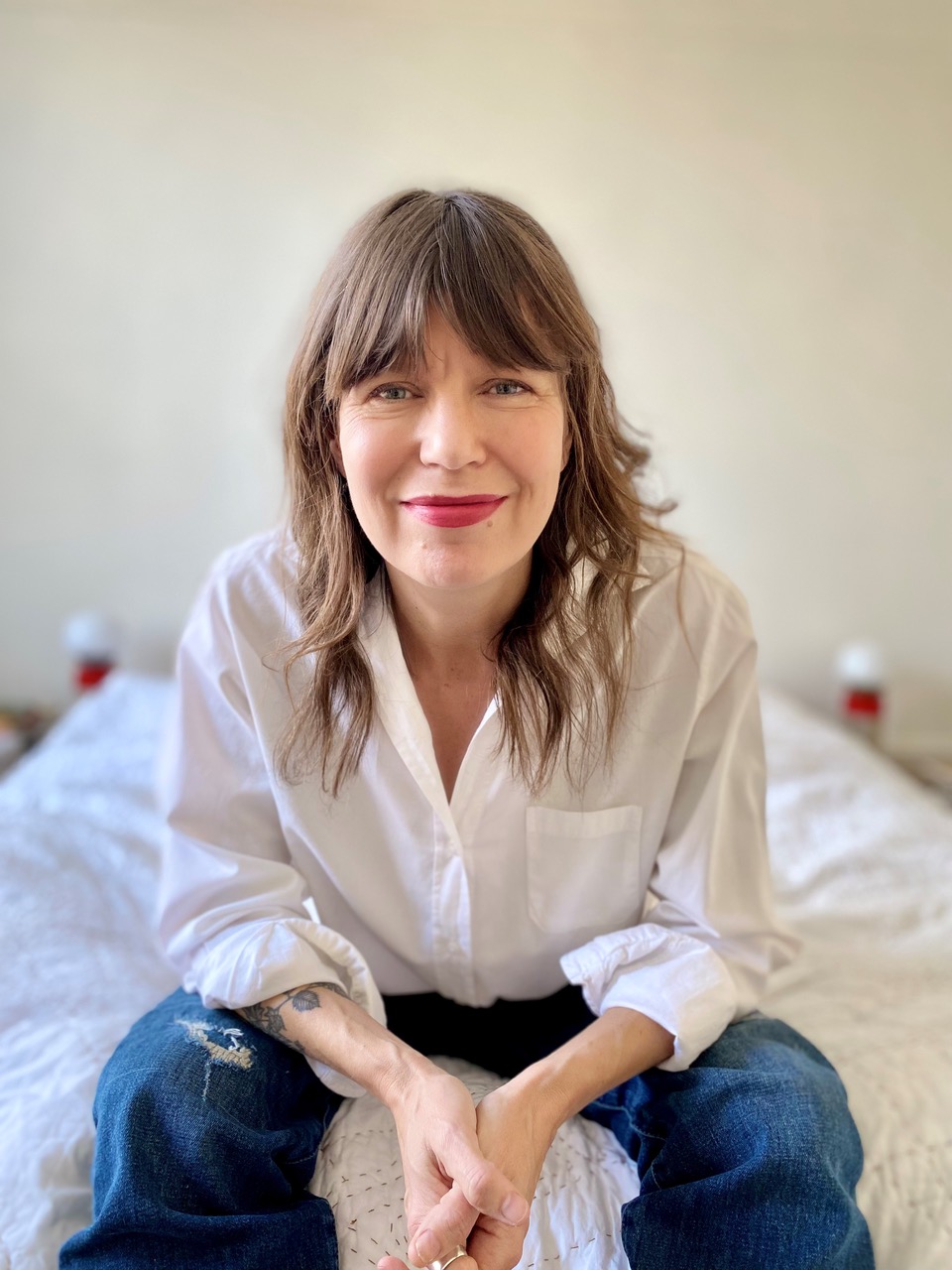 |
|
| E. Lockheart (photo: Heather Weston) |
|
E. Lockhart is the author of We Were Liars and its prequel, Family of Liars. Her other books include Genuine Fraud, Again Again, Fly on the Wall, Dramarama, The Disreputable History of Frankie Landau-Banks (a National Book Award finalist and Printz Honor Book), and the Ruby Oliver Quartet. Lockhart holds a doctorate in English literature from Columbia University and lives in Brooklyn, N.Y. We Were Liars has became extremely popular on BookTok, and a TV series based on the book debuted in June 2025. The third book in the Liars series, We Fell Apart (Delacorte), is out now.
When We Were Liars came out in 2014, it received all the awards and honors. Now, it's having a whole second life. How does it feel to be a BookTok celebrity?
Basically, I feed on people's tears like an emotional vampire, and it keeps my skin looking really, really good. We Were Liars blew up on BookTok in 2020, and I think the reason was that it's a cathartic read. People were isolated and disconnected, so they were hungry to read books that offered big emotions. The response to the TV show based on the book has been the same. Lots of tears, and lots of people watching it a second time, a third, a 10th.
Was it that resurgence of excitement that led to Family of Liars, the TV series, and now We Fell Apart? Or were those already in the works?
In 2020, I published a book I felt very proud of (Again Again) and it hadn't found its audience. At all. At the same time, I had a bestseller with We Were Liars. I knew what a gift it was to have readers, especially readers who were making creative videos in response to a story of mine. I wanted to give them something back, so I wrote Family.
Did you know the background described in Family of Liars while writing We Were Liars?
I made it all up later.
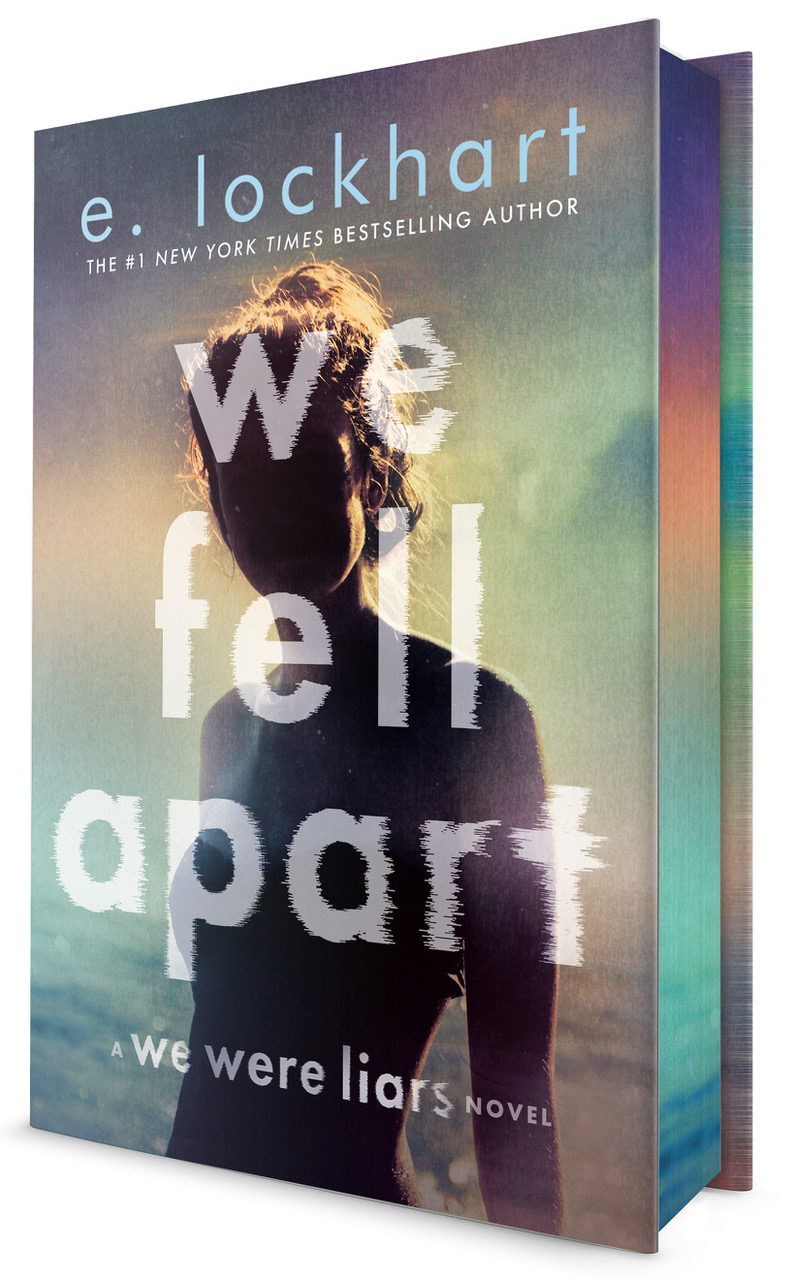 In the bonus material at the end of Family of Liars, you say that the idea for the book came to you through focusing on Beechwood Island being "a place that welcomes ghosts." How did the idea for We Fell Apart come to you?
In the bonus material at the end of Family of Liars, you say that the idea for the book came to you through focusing on Beechwood Island being "a place that welcomes ghosts." How did the idea for We Fell Apart come to you?
I got the idea for We Fell Apart when visiting the now-derelict summer home of a famous architect. It had towers like a castle, a circular pool, guesthouses and outhouses in massive states of disrepair, and an overgrown garden. I felt like I was walking into a novel, and I started writing that night.
We Fell Apart and Martha's Vineyard, where it takes place, has such a different vibe from Beechwood. How do you think readers will react to this expansion in the way you approach wealth, family, race, and relationships?
To me, it's the same vibe--a beachy gothic story full of love and mystery that's narrated by a passionate, difficult girl, centered on her relationship to her family and the deep friendships that form on a summer vacation, seeded through with fairy tales that offer insights into the true nature of the situation. The racial tensions that thread through We Were Liars are less of a focus, but the homophobia and misogyny that thread through Family of Liars are certainly part of We Fell Apart, too. Like the other books, it's about a patriarchal family structure that causes a lot of damage.
Matilda is unlike your previous protagonists; she's dealing with many of the same things that Cadence and Carrie did but ultimately takes very different steps. How did you develop Matilda?
Both Carrie and Cadence are insiders to a world of wealth and privilege. They come to an understanding of the way that has shaped their characters and figure out who they want to be. In contrast, Matilda has been raised by a single mom with very little money, so when she comes to the island to meet the father she's never known, she's an outsider to the life he's built, where he's the king of this strange and beautiful castle. Matilda is more like me.
What are you hoping readers take with them from We Fell Apart?
I hope the story is propulsive and highly emotional, but I don't write for my readers to have a simple takeaway. A story is sticky when it's complicated.
How do you feel about We Fell Apart?
It's my most romantic novel, and I'm proud of that.
Is there anything else you'd like to tell readers or anything you're working on that you'd like to discuss?
If you've never read anything by me, you can start with We Fell Apart. It links up with We Were Liars and Family of Liars, but it can stand alone. --Siân Gaetano, children's and YA editor, Shelf Awareness
Book Candy
Book Candy
Mental Floss offers "8 Utopian Fiction Novels to Get You Through These Dystopian Times."
---
The huge bell ("Gongen," or "the Gong") of the main library in Aarhus, Denmark, rings when a child is born in the city, Atlas Oscura notes.
---
CrimeReads recommends "11 Mystery Novels That Explore the Power of Rumors and Gossip," including work by Dorothy L. Sayers, Josephine Tey, and Un-su Kim.
What Sheep Think About the Weather: How to Listen to What Animals Are Trying to Say
by Amelia Thomas
As journalist Amelia Thomas settled into life on a Nova Scotia farm, she developed a "desperate urge to vault the species divide" and converse with her menagerie and the surrounding wildlife. Asking herself, "How can I better understand the animals in my life?," she set off on a yearlong quest to build up her knowledge and enhance her relationships. Rooted in her home space but ranging through research, travel, and interviews, she learned all she could from scientists, trainers, and animal communicators. With curiosity as her guide, she also undertook simple behavioral experiments. What Sheep Think About the Weather is the result: a comprehensive yet conversational book that effortlessly illuminates the possibilities of human-animal communication.
Thomas was always an animal lover, rescuing bedraggled pigeons and keeping everything from guinea pigs to a wallaby as pets. As a travel writer, she encountered exotic animals, too. But the other-than-human encounters ramped up on her new farm. One spur to her project was learning about Simona Kossak (1943-2007), a Polish scientist and animal trainer known for her listening skills. Kossak became a professor of forest sciences as well as national director of the Department of Forests, while living deep in the woods surrounded by myriad animals, like a lynx and a raven. Kossak seemed to combine the best of the hard and soft sciences, a love of pets and a rigorous scientific background.
"Science scares me," Thomas confesses, but in her keenness to learn she started reading all the scientific papers and reports she could get her hands on. As she researched, she realized that science arises from natural inquisitiveness and, rather than demanding flawless results, rewards sincere attempts. With this in mind, she lined up an impressive roster of researchers who shared their work on animals' personalities, vocalizations, and other forms of communication. This is the substance of Part I of What Sheep Think About the Weather, "The Thinkers."
Two things soon become evident. First, with the exception of some dogs and parrots that have been taught to mimic human speech, animals don't "talk" in ways we expect; other senses predominate. Smell and body language are crucial, and tone of voice might outweigh the actual words spoken. Thomas is earnest and unafraid to try things that might seem ridiculous, such as sniffing on her hands and knees alongside her dogs to see the world their way, or assembling a "pigtionary" of her Kunekune piglets' vocalizations.
Second, it is essential to treat animals as individuals. Isaac Planas-Sitjà, an assistant professor at Tokyo Metropolitan University, has proven personality in cockroaches: they have distinct characteristics ("bold versus shy, social versus nonsocial, risk taking versus risk averse") and make choices not based on instinct. (Thomas then seeks to replicate this experiment at home with her 11-year-old son and a group of racing earwigs.) Likewise, Rachel Mundy, a musicology professor at Rutgers University, teaches her students to recognize particular robins based on their song patterns. When Thomas visits a battery chicken farm, she is reminded that each of these creatures matters as much as her hens, yet humans choose to view them as a commodity.
Some of the individual animals discussed may be familiar. Trained by animal psychologist Irene Pepperberg, Alex the African gray parrot learned more than 100 words and was able to ask questions; Koko the western lowland gorilla knew 1,000 American Sign Language signs. But the history of experimentation with chimpanzees--medical or otherwise--is a sad one. Dr. Mary Lee Jensvold was involved in Project Washoe, a long-running ape language experiment, but concluded, "we must never do these experiments again" because she feels it is cruel to keep such intelligent animals imprisoned in cages.
"The more we listen, the more we know about animals' lives," Thomas writes. "The more we know... the more we tend to care." Empathy is a necessary foundation for animal training, the subject of Part II, "The Doers," as well as for "intuitive interspecies communication," one of the techniques discussed in Part III, "The Feelers." Thomas meets horse whisperers and dog trainers and goes out in the field with a tracker and an animal communicator. What she learns helps her to improve her dogs' behavior and better understand her ailing horse Major's pain--and know when it's time to let him go.
Alternating between research, discussions with experts, and her experiences on the farm, Thomas maintains an engaging pace. She synthesizes mountains of information and big scientific concepts such as theory of mind and operant conditioning into hugely readable prose. The book ranges through history, from the Greek philosophers to Darwin to today's researchers. Full of fascinating facts wittily conveyed, it elucidates science and nurtures empathy. Thomas's genial tone will make readers feel they know each of the pets and wild animals described.
Ideal for fans of classic animal writings (e.g., Gerald Durrell and James Herriot), What Sheep Think About the Weather also recalls popular science writers including Temple Grandin, Sy Montgomery, and Ed Yong. The message has never been more important: listening is what "makes humans humane" and "there's no 'us and them': rather, infinite varieties of 'us.' " --Rebecca Foster
"All We Have to Do Is Stop and Listen"
An Interview With Amelia Thomas
 |
|
| Amelia Thomas | |
Amelia Thomas has contributed to more than a dozen Lonely Planet books. Her journalism has appeared in the Christian Science Monitor, CNN Traveler, the Middle East Times, the Sunday Times, and the Washington Post. Her previous book, The Zoo on the Road to Nablus (2008), inspired the documentary Waiting for Giraffes. Thomas attended Cambridge University and holds a diploma in equine psychology. She lives on a farm in Nova Scotia and practices equine bodywork for charitable organizations. Her new book, What Sheep Think about the Weather (Sourcebooks, November 4, 2025), delves into human-animal communication.
Would you share a bit about Simona Kossak and how she inspired your project?
A few years ago, a friend sent me a black-and-white photo of a Pippi Longstocking-ish young woman in a cardigan, gazing adoringly at an enormous wild boar who is busy nibbling crumbs from her dining table. This was my first glimpse of Kossak, a Polish naturalist who shunned her family's high-society Krakow lifestyle to live deep in the Bialowieża forest with a menagerie of animals--some domestic, but many others wild--and her partner, Lech Wilczek, a wildlife photographer. Immediately intrigued, I sought out all I could about her. The more I learnt, the more I aspired to Simona's ease with the natural world surrounding her, and to her apparently effortless understanding of what all kinds of animals--her pet boar Żabka included--were telling her. Fast-forward to 2023. A new farm and host of unruly pets conspired to send me diving into the question Simona first teased loose: How can we best understand what animals are trying to say, not to each other--but to us? And my family has Simona to thank for Constance and Agnes, two ginger-haired pet Kunekune pigs, named after my red-headed grandma and great-aunt.
In the first chapter, you write about your fear of science. How did you go about defusing that and building a new understanding?
When I attended a drafty old girls' school in England, Mr. Heap, our ancient science teacher, seemingly had only two lesson plans: endless demonstrations of a similarly decrepit Van de Graaf generator, or timed tests on the 118 elements of the periodic table. I grew up thinking science was inscrutable, difficult, and boring, and that I, with my interest in arts and poetry, wasn't clever enough to understand. Researching this book cured me of this misbelief, because science and the arts, I found, have more commonalities than I'd ever imagined. The best scientists, I realized, are no more certain about things than the best poets: they are seekers with insatiable curiosity, on the hunt for new discoveries and understandings. This broke down a barrier for me. I concluded that good science is about the right question, not the right answer. Keats talked about "negative capability"--being able to sit with feelings of uncertainty or mystery without immediately being able to explain them away. Professor Irene Pepperberg told me something similar: if you're certain something doesn't exist, wait a decade or two and you'll probably be proved wrong.
You class experts under the headings "Thinkers," "Doers," and "Feelers." How have you tried to be all three?
The lessons I learnt during my year of deep listening have carried over into every aspect of my life, far beyond the realm of listening to animals. For example, I find frequently that when I'm stumped by a work question--or even a personal one--I default to a quick list of questions. What do I know, think I know, or need to know, about the problem (the thinking)? What methods can I learn or use to overcome it (the doing)? And what do I intuit (or feel) about what to do? I've noticed that running through this three-part mental checklist helps me go from a state of worry or panic to a plan of action every time.
You note that most of your favorite scientists are over 70. Is animal communication a dying art?
While it's true that many of my favourite scientists (like the delightful and prolific ethologist Marc Bekoff, or Con Slobodchikoff, who studied prairie dogs' fascinating "language") are well over 70, there's a host of wonderful younger researchers discovering amazing things: for instance, Australian Dr. Alex Schnell, who proved cuttlefish can pass the Stanford "Marshmallow Test," and Dr. Cat Hobaiter in the U.K., who is one of the founders of the Great Ape Dictionary. In the U.S., there's Dr. Denise Herzing, who has spent decades studying a group of wild dolphins in the Caribbean. In Brazil, turtle researcher Camila Ferrara has found that mother turtles, previously thought to be silent, actually vocalize to their hatchlings. I admire all these scientists, because each knows the importance of what Dutch biologist Niko Tinbergen, in his 1973 Nobel Prize acceptance speech, called "the old method of 'watching and wondering.'" Despite recent interest in using AI to "decode" animal communication, there are still plenty of younger people out there in the field who know that to better understand what animals are saying, there's still no substitute for putting in careful hours with one's old-fashioned eyes and ears.
Animals (generally, their deaths) are often used in literature as portents. Does this offer useful lessons, or cheapen them as individuals?
The fact that animals' deaths are so frequently used as symbols in literature shows, I think, just how powerful their individual influences on our human lives really are. Take Coleridge's "The Rime of the Ancient Mariner": shooting that single albatross doomed the entire crew to destruction. Or Old Yeller and Greyfriars Bobby. Both symbolize canines' devotion to their human companions, but that doesn't make their individual deaths any less moving. The same goes for the death of Aslan, for example, in The Lion, the Witch and the Wardrobe, or of Pimpernel in Watership Down. And then there's Orwell's Animal Farm, the book that devastated me as a child; we all know it's an allegory, but what adult doesn't weep, even now, at the fate of Boxer?
What are non-animal lovers missing out on?
Even people who wouldn't consider themselves nature or animal lovers might find comfort in seeing cattle grazing peacefully on a sunset marsh, or have their emotions stirred by a flock of wild geese flying overhead on a crisp fall night. But it's easy to become so wrapped up in our human world that we can forget we, too, are part of nature: that there's really no "us" and "them" at all. Luckily, though, nature is inescapable, even on city streets. There you'll find weeds or ants or common or garden city pigeons, all of whom--historically, botanically, phylogenetically, behaviorally, microscopically--are really interesting. And it's great that nature is always there. Because aside from the well-documented emotional and mental health benefits offered by interacting with the natural world--be it listening to birdsong, petting a dog, or walking in the woods--the non-human world offers us all a sense of unjudgmental and profound connection, far deeper than the kind we're endlessly seeking in our ever-more connected, social media-dominant human world. And all we have to do to access it is to stop and listen. --Rebecca Foster
Rediscover
Rediscover: Susan Griffin
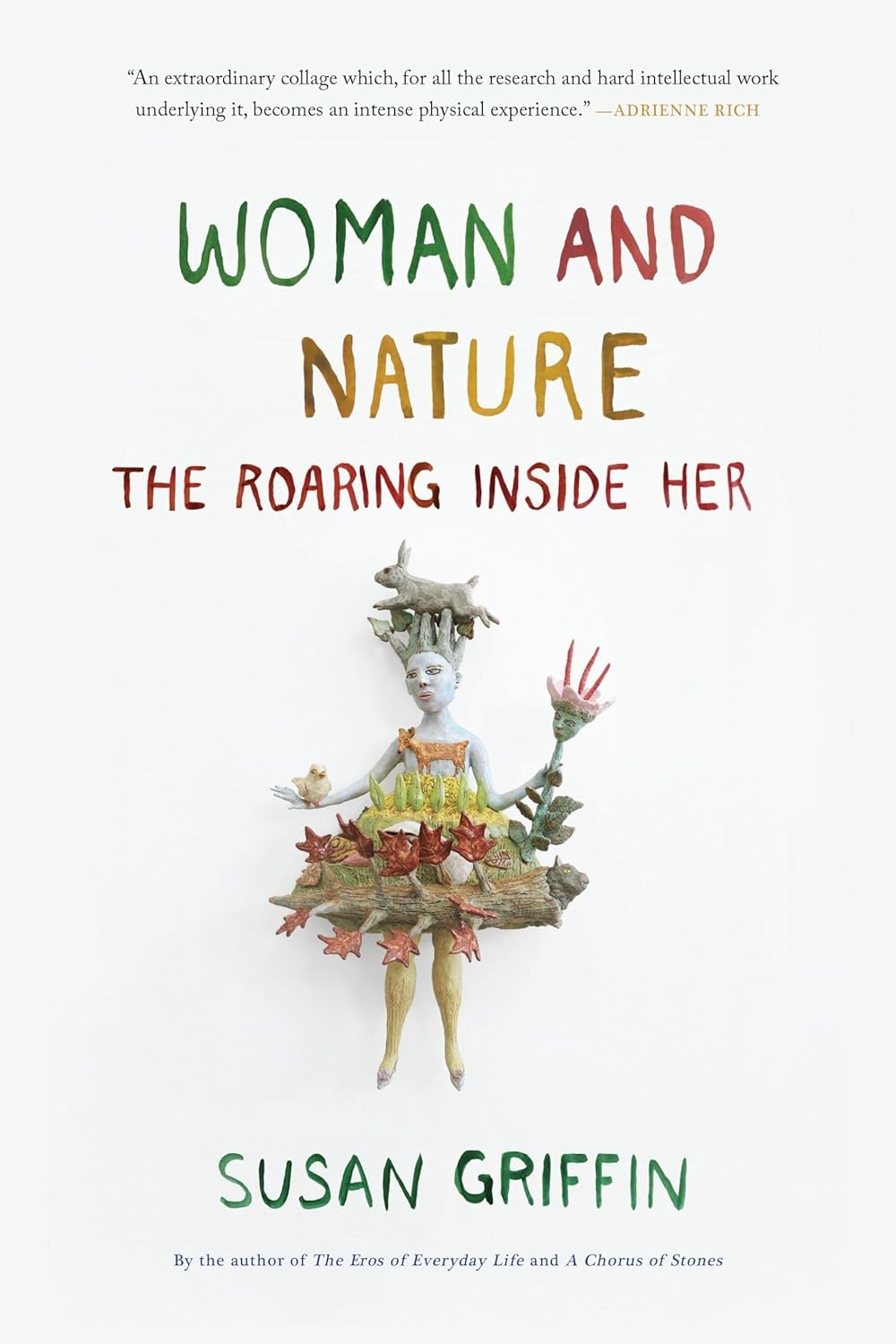 Susan Griffin, an influential poet, playwright, and prolific feminist author "who pioneered a unique form of creative nonfiction, blending propulsive, poetic prose with history, memoir and myth in books like Woman and Nature: The Roaring Inside Her," died in late September at age 82, the New York Times reported. Griffin focused on the effects of a patriarchal Western belief system, exploring "how capitalism, science, religion and even the porn industry have subjugated the natural world to its detriment and ours, and how that subjugation is a gendered one."
Susan Griffin, an influential poet, playwright, and prolific feminist author "who pioneered a unique form of creative nonfiction, blending propulsive, poetic prose with history, memoir and myth in books like Woman and Nature: The Roaring Inside Her," died in late September at age 82, the New York Times reported. Griffin focused on the effects of a patriarchal Western belief system, exploring "how capitalism, science, religion and even the porn industry have subjugated the natural world to its detriment and ours, and how that subjugation is a gendered one."
Griffin was among those who contributed to the intellectual life of Berkeley, Calif., "through their writings, activism, bookstores (like Cody's Books, a hub for the counterculture and free-speech activists), and restaurants (Alice Waters's Chez Panisse, among others)," the Times noted.
She was one of the first poets published by Shameless Hussy Press. In 1975, Griffin won an Emmy Award for Voices, a play about the experiences of five women that was shown on public television and later staged around the world.
Griffin's book Woman and Nature (1978), however, "made her a feminist rock star," the Times wrote, adding that it focused on "the violence that men have perpetrated on the natural world, and on women, and how it would benefit the planet to rethink the more dangerous advances of modernity and technology."
She dedicated the book to her friend, the poet Adrienne Rich, who called it "perhaps the most extraordinary nonfiction work to have emerged from the matrix of contemporary female consciousness, a fusion of patriarchal science, ecology, female history and feminism, written by a poet who has created a new form for her vision."
Rebecca Solnit, the feminist author and activist, called Griffin "one of the senior public intellectuals of Berkeley.... I can't think of anyone else who brought that kind of poetics and visionary quality to writing about intensely political subjects."
Her other books include Rape: The Politics of Consciousness (1979), Pornography and Silence: Culture's Revenge Against Nature (1981), Unremembered Country: Poems (1987), A Chorus of Stones: The Private Life of War (1993), The Eros of Everyday Life: Essays on Ecology, Gender and Society (1995), Bending Home: Selected New Poems, 1967-1998 (1998), What Her Body Thought: A Journey into the Shadows (1999), The Book of the Courtesans: a Catalogue of Their Virtues (2001), and Wrestling with the Angel of Democracy: On Being an American Citizen (2008).
Poetry is "like music," Griffin told the Times in 2024. "It expresses things you haven't quite integrated into your rational mind. It's the cutting edge of social change. Things would come out in poetry that later could be articulated in policy or ideas."
| Advertisement nuremberg--now playing in theaters |


